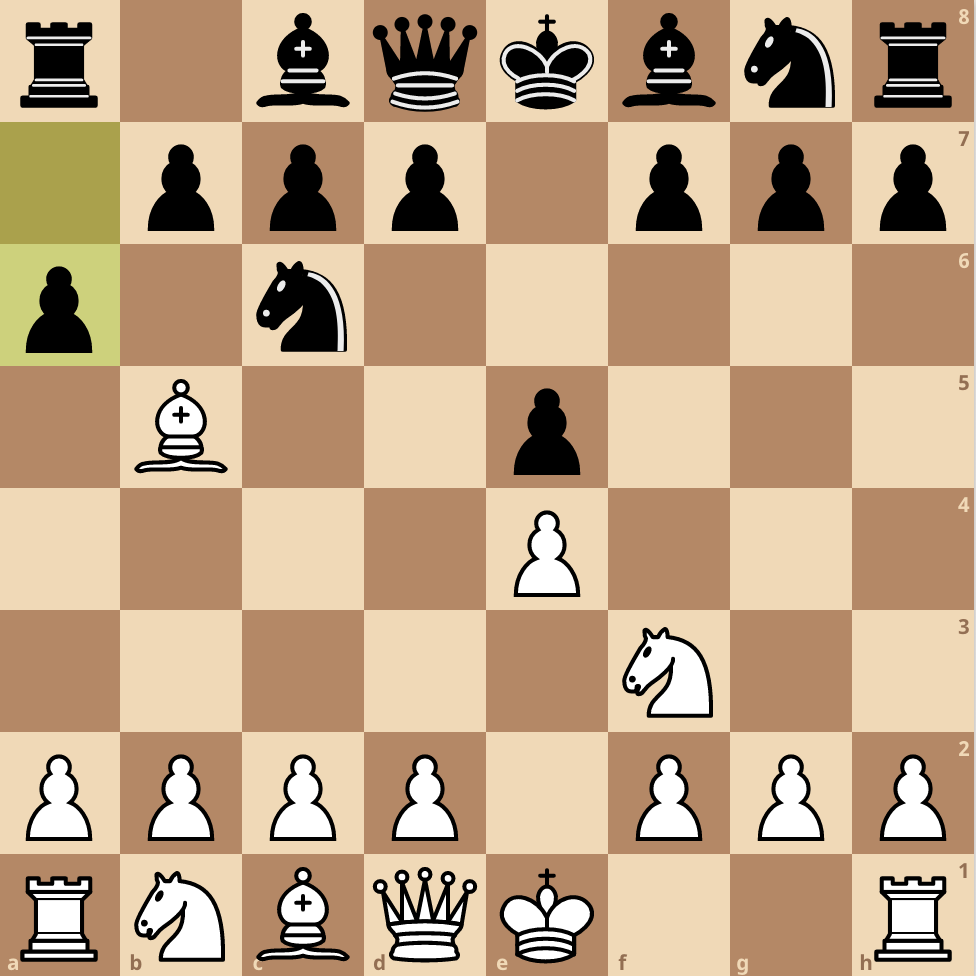Master the Ruy Lopez Opening


William T Green
Ruy Lopez
Vladimir Fedoseev vs. Denes Boros
PGN:
1. e4 e5 2. Nf3 Nc6 3. Bb5 Bd6 4. O-O Nge7e 5. c3 O-O 6. Re1 a6 7. Bf1 f5 8. Bc4 Kh8
9. d4 b5 10. bb3 f4 11. g3 Ng6 12. h4 fxg3 exd4 13. fxg3 exd4 14. Ng5 Qf6 15. Qe2 Bxg3
16. Nxh7 Qf2 17. Qxf2 Bxf2 18. Kh1 Kxh7 19. Rf1 Bb7 20. h5 Nge5 21. Kg2 Be3 22. Bxe3 Rxf1
23. Kxf1 dxe3 24. Ke2 Rf8 25. Na3 Rf2 26. Kxe3 Ng4 27. Kd3 Nce5 28. Kd4 d6
Key Takeaways & Analysis:
The opening is the Ruy-Lopez, characterized by 3. Bb5, which is one of the oldest and most classic of all openings. After 4. O-O, we transition into the Closed Defense with the move 4...Nge7.
In response to 7...f5, White decides to retreat the bishop to c4 instead of taking on f5 or playing d4 immediately, which could lead to some very sharp lines.
After 9...b5, Black has been able to successfully kick the bishop away and has gained space on the queenside. The move 10...f4 initiates an aggressive pawn storm on the kingside, which White tries to counter with 11.g3.
After 13...exd4, 14.Ng5 is a strong move, threatening Qh5 with a potentially lethal attack on h7.
After 16...Qf2+, Black wins the exchange but gives White the opportunity to simplify the position a bit and alleviate some of the pressure.
Move 20...Nge5 is well timed, aiming to simplify the position further and exploit the e-file while the White king is still in the center.
With 26...Ng4+, Black is maintaining the initiative and forcing White's king to an awkward square.
At move 28...d6, we see a very complicated middle-game position where both sides have chances. It seems that Black has the upper hand due to better piece coordination and more active pieces.
Prasanna Raghuram Rao vs. Opuriche Durrohoa-Ihemebiri
PGN:
1. e4 e5 2. Nf3 Nc6 3. Bb5 Bc5 4. d3 a6 5. Ba4 Nf6 6. O-O O-O 7. Bxc6 dxc6 8. Nxe5 Be6 9. Nc3 Re8 10. Nf3 Qd7 11. e5 Nd5 12. Ne4 Be7 13. h3 h6 13. Re1 Bf5 15. Ng3 Bc5 16. d4 Bb6 17. c3 c5 18. dxc5 Bxc5 19. Nxf5 Qxf5 20. Qxd5 Bd6 21. g4 Qc2 22. exd6 Rxe1 23. Nxe1 Qe3 24. Qd2 Qe6 25. dxc7 b6 26. Qd8 Rxd8 27. cxd8=Q Kh7 28. Be3 Qe4 29. Rd1 h5 30. gxh5 Qf5 31. Qd3 g6 32. Qxf5 gxf5 33. Rd6 f4 34. Bxf4
Key Takeaways & Analysis:
e4 e5 2. Nf3 Nc6 3. Bb5 - This is the Ruy-Lopez opening, a classic and aggressive opening choice from White.
4...a6 5. Ba4 Nf6 6. O-O O-O - These moves are standard for this opening, with both sides continuing to develop their pieces.
Bxc6 dxc6 8. Nxe5 - With this exchange, White gets an advantage in material but also doubles Black's pawns on the c-file.
Nc3 Re8 10. Nf3 Qd7 11. e5 Nd5 12. Ne4 Be7 - The game remains quite balanced, with both sides maneuvering their pieces to optimize their positions.
h3 h6 13. Re1 Bf5 15. Ng3 - White plans to reposition the knight, possibly eyeing the f5 square.
dxc5 Bxc5 - Black has a slight advantage in development and an unbalanced pawn structure.
Qxd5 - White decides to exchange queens and enters an endgame with a slight advantage due to the passed d-pawn.
exd6 Rxe1 23. Nxe1 - White takes advantage of the open e-file, aiming to promote the passed pawn.
Qd2 Qe6 25. dxc7 - With this pawn move, White creates a potentially winning passed pawn.
Be3 Qe4 - Despite being a rook down, Black continues to seek counterplay.
gxh5 Qf5 - With this pawn capture, White creates a dangerous passed h-pawn, further increasing their advantage.
Bxf4 - The final move concludes the game, with White having a decisive material advantage and a clearly winning position.
Overall, this was an exciting game with a number of intriguing tactical moments. Despite an equal opening, White managed to create imbalances in the pawn structure and capitalize on these in the endgame.
Garry Kasparov vs. Roman Cerulik
PGN:
1. e4 e5 2. Nf3 Nc6 3. Bb5 Bd6 4. O-O Nge7 5. c3 O-O 6. d4 a6 7. Bd3 Ng6 8. Re1 b5 9. a4 Bb7 10. axb5 axb5 11. Rxa8 Qxa8 12. Bxb5 Ba6 13. Bxa6 Qxa6 14. h4 Be7 15. h5 Nh4 16. Nxe5 Nxe5 17. dxe5 Qe6 18. Bf4 g6 19. Nd2 g5 20. Bg3 d5 21. exd5 Qxd5 22. Ne4 Qxd1 23. Rxd1 f6 24. exf6 Bxf6 25. Rd7 Rf7 26. Rxc7 Kg7 27. Rxf7 Kxf7 28. Nxf6 Kxf6 29. Bxh4 gxh4 30. b4 Kg5 31. b5 Kxh5 32. b6 Kg4 33. by h3 34. b8=Q hxg2 35. Kxg2 h5 36. Qe5
Key Takeaways & Analysis:
This game starts with a Ruy-Lopez opening, with both sides quickly developing their pieces.
e4 e5 2. Nf3 Nc6 3. Bb5 Bd6 4. O-O Nge7 5. c3 O-O 6. d4 - Both sides are developing their pieces and controlling the center.
6...a6 7. Bd3 Ng6 8. Re1 b5 9. a4 Bb7 10. axb5 axb5 11. Rxa8 Qxa8 - White wins the rook and then chooses to exchange it for Black's knight.
Bxb5 Ba6 13. Bxa6 Qxa6 14. h4 Be7 15. h5 Nh4 16. Nxe5 Nxe5 17. dxe5 Qe6 - White opens up the h-file, aiming to create some threats in the future, while Black's queen is developing, targeting White's weak pawn on e5.
Bf4 g6 19. Nd2 g5 20. Bg3 - White plays Bf4 to secure the pawn on e5, but Black responds with g5, attacking the bishop and trying to create counterplay.
Rxd1 f6 24. exf6 Bxf6 25. Rd7 Rf7 26. Rxc7 Kg7 27. Rxf7 Kxf7 28. Nxf6 Kxf6 - White secures a pawn advantage in the endgame after a series of exchanges.
Bxh4 gxh4 30. b4 - White starts pushing their b-pawn, planning to create a passed pawn.
b6 Kg4 33. by h3 34. b8=Q hxg2 35. Kxg2 h5 36. Qe5 - The pawn promotion to a queen ultimately ends the game, as Black has no real chances to stop the new queen.
White's pawn advantage from the middle game proved decisive in the endgame, leading to a clear victory. The game displayed tactical foresight from both sides, as well as careful endgame technique from White.